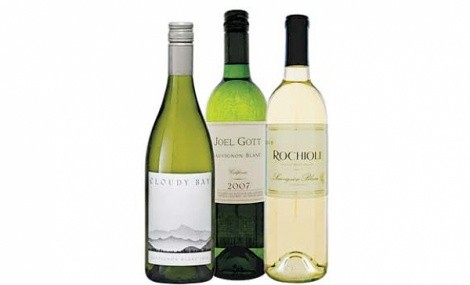
People seem to either love or hate Sauvignon Blanc. There’s not much middle ground. And, granted, it’s not for everyone and is certainly not a “beginner” wine. At worst, Sauvignon Blanc can taste like a poor knock-off of a shabbily made California Chardonnay: one-dimensional and loaded with oak. At its best, Sauvignon Blanc is delicious, herbal, intriguing and a perfect accompaniment to foods like shellfish, sushi and goat cheese. Interested?
With the exception of some heavy-handed California producers, Sauvignon Blanc—the white wine made from the Sauvignon Blanc grape—is usually a very dry, starkly acidic wine with little or no oak flavor. Most of the best Sauvignon Blanc is aged in stainless-steel tanks. But, increasingly, particularly in California, barrel fermentation is being employed, which serves to diminish the wine’s herbal qualities. The result of fermenting in oak is, in my opinion, most often a bastard of a wine that leans toward California Chardonnay and more often than not sacrifices acidity—what Sauvignon Blanc is all about—for smoothness. Chardonnay is loved for its buttery roundness; Sauvignon Blanc, by contrast, has laser-like acidity and is lean and mean. In fact, the word Sauvignon comes from the French sauvage, meaning savage or wild.
The most sought-after Sauvignon Blanc comes from France’s Loire Valley—in the form of Sancerre and Pouilly-Fumé—and from New Zealand, the Marlborough region. Virtually all the white wines from Bordeaux are made from Sauvignon Blanc, with the addition of Sémillon.
When wine experts talk about Sauvignon Blanc, they typically use words like “vegetal” and “herbaceous” to describe the flavor. And Sauvignon Blanc does have a veggie/herbal sort of taste, which makes it an excellent choice for food-pairing puzzlers like asparagus, artichokes or lighter foods seasoned with fresh herbs. Indeed, there are certain Sauvignon Blancs that even taste like asparagus, although subtly so. “Grassy” is another way to describe Sauvignon Blanc.
Sauvignon Blanc from warmer climates (like California, where it’s also called Fumé Blanc) can taste of ripe melons. With more vegetal varieties—and vegetal flavors can be a sign of poorly made Sauvignon Blanc—I often taste green bell peppers. Most often, though, the key flavor I get from Sauvignon Blanc is grapefruit.
If you’re at all seduced by Sauvignon, I recommend heading to the wine store and picking up a selection of bottles from different countries and different regions and throwing a Sauvignon Blanc tasting to discover which, if any, you enjoy. I’d suggest picking up a good French Sancerre or Pouilly-Fumé from a quality producer like Pascal Jolivet or Chateau Smith Haut Lafitte and drinking it alongside Sauvignon Blanc from Chile, like Montes or Cono Sur. Next, open a Kiwi Sauvignon Blanc such as the classic Cloudy Bay or Kim Crawford. Finally, toss in a Sauvignon Blanc or Fumé Blanc from California for good measure. Set out a platter of cold crab, asparagus and goat cheese and sample these wines with friends.
Among my favorite California renditions of Sauvignon Blanc are Joel Gott, a very clean and straightforward example of the varietal and a steal at $10.99; Charles Krug ($16.99); St. Supery ($17.99); Spottswoode ($29.41); and my favorite, Rochioli ($36.94). Although Rochioli Sauvignon Blanc is barrel-fermented, imparting complexity and a round texture, it’s not a heavy-handed oak bomb. Only 22 percent of the wine is fermented in oak; the rest is tank-fermented, giving it firm acidity.
Of course, you also need to try the quintessential expression of New Zealand Sauvignon Blanc, the aforementioned Cloudy Bay ($25.99). This is the NZ SV to which all others are compared. But, for a few less shekels ($12.99), I’d also give Oyster Bay Sauvignon Blanc a go.